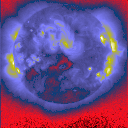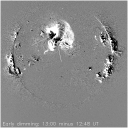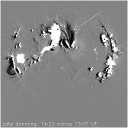
Coronal dimming, seen in soft X-rays, should rightly be regarded as one of Yohkoh's major discoveries. But was it really a new discovery? Colleagues probably suspect us of introducing a new term so as to be able to ignore previous work on this subject! This would be an example of the academic sin of over-neologism. Indeed Skylab had already observed "transient coronal holes" in soft X-rays, and ground-based observers had observed "depletions" in visible light. But the varieties of dimming observed by SXT certainly include some new ones, and the term "transient coronal hole" seems too precise and presumptive to fit them all. So - "dimming" it is, and please see our earlier nuggets for fuller details.
The observations reported here, from Feb. 15, 2001, add to the dimming lore we're accumulating.
The subject here is a sigmoid => arcade event, displaying transient coronal holes, that apparently led in some fashion to a "moving cloud" dimming. The whole event was complicated by the presence of large-scale coronal effects in various other regions; these also could have been related to the global effects of the event that we observed and/or its associated CME. For a well-isolated example of global X-ray brightening, see the October 5, 1996 event displayed below (thanks to L. Acton):

The inset shows an SXT difference image (click to blow up and be able to read the time labels); the outer image is from LASCO and shows the CME together with a glimpse of the erupting prominence below it. SXT saw bright strands of hot material erupting, and the dark blob is the resulting dimmed coronal volume. The bright cusp-shaped regions at the northwest and soutwest limbs constitute the global X-ray brightening, which was probably easy to see here only because the Sun was so amazingly quiet on the visible hemisphere.
The "double dimming" (double in time, not bipolar as in the transient coronal holes) appears in two difference images displayed below:
 |
 |
 |
The relationship between the two parts of the event can't be discerned from a nugget-type analysis. The time scale is short, but seemingly not short enough to result from an MHD wave disturbance; on the other hand it seems much longer than emerging-flux time scales. We could use the word "trigger" but would hardly know what we meant by it! Nevertheless this is one of those cases where a coronal disturbance does not focus entirely down to a compact origin (eg a major impulsive flare); instead, even though active regions (rather than streamers as such) are involved, there are distinctly global effects. At just about the same time as these dimming phenomena, we see a major coronal brightening in the east, and even a faint burst of activation in the faint "anemone" region seen to the south. So lots of corona might have been implicated here!
February 23, 2001